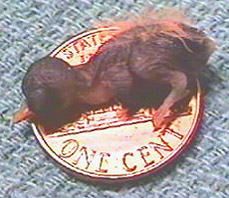

 |
 |
|
|
The male ruby-throated hummingbird (above left) has a red patch under his chin. The female (right) lacks the red patch and is mostly green with a light underside. Immature males are nearly impossible to tell from females in late summer. Remember that ruby-throated hummingbirds are the only species to regularly nest east of the Mississippi River. During migration, many ruby-throated hummingbirds make an incredible 18 hour trip across the Gulf of Mexico, arriving totally exhausted at their destination. |
Ruby-throated hummingbirds usually arrive in central Illinois around May 1, so it is a good idea to have your feeders in place by mid-April. (See the box below for more tips on attracting hummingbirds). Experts advise people to leave their hummingbird feeders up into November. That's long after most have left central Illinois,but many of the rare or unusual hummingbirds that appear in Illinois seem to be spotted late in the season. |
|
Tips for attracting hummingbirds: 1. Change the sugar/water mixture in your hummingbird feeder every few days, especially during hot weather. Some people change the mixture daily when it is especially hot. 2. Do not dye the mixture red. This is not necessary. The red color of the feeder is sufficient. If you feel the hummingbirds need a stronger clue, attach a red ribbon or streamer that will flutter in the breeze. |
3. The recipe is four parts water to one part sugar. Add sugar to boiling water and stir until dissolved. 4. Place a second feeder out of sight of the first one. Hummingbirds will defend all of the feeding stations they can see from one perch. 5. Add hummingbird friendly plants to your property. Trumpet vine, trumpet honeysuckle vine, cardinal flower and bee balm will help. Plants native to your area are the best choice for attracting birds, butterflies and wildlife. |
 |
 |
|
 |
 |
|
| Baby hummingbirds are no bigger than a penny. To learn more about them and see another picture. |  |
|